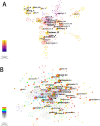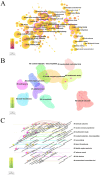Research status and trends of drug-coated balloons in coronary artery disease: a bibliometric analysis
- PMID: 40901519
- PMCID: PMC12399631
- DOI: 10.3389/fmed.2025.1591906
Research status and trends of drug-coated balloons in coronary artery disease: a bibliometric analysis
Abstract
Objective: Drug-coated balloons have emerged as a pivotal alternative to drug-eluting stents in the interventional management of coronary artery disease, particularly showing clinical advantages in the treatment of in-stent restenosis and small-vessel disease. This study provides a systematic bibliometric analysis of publication trends, research hotspots, and future directions in DCB-related CAD research from 2004 to June 2025.
Methods: A total of 1,092 publications indexed in the Web of Science, Scopus, and PubMed databases were analyzed using CiteSpace, VOSviewer, and bibliometrix. Inclusion criteria were English-language papers, while case reports, conference proceedings, news articles, and duplicate publications were excluded. The analysis focused on publication trends, country/institutional contributions, author collaboration networks, journal analysis, co-citation literature, and keyword evolution.
Results: Three distinct developmental phases of DCB research were identified: (1) device optimization (2004-2010), (2) clinical validation (2010-2017), and (3) application to complex lesions (2018-present). China led in publication volume (n = 180), while Germany and Italy demonstrated the highest research impact. Leading research institutions included Capital Medical University and Friedrich Schiller University of Jena. High-impact journals such as JACC: Cardiovascular Interventions and EuroIntervention served as key publication venues, with a focus on clinical outcomes and intravascular imaging. Keyword analysis revealed a growing emphasis on intravascular imaging modalities and emerging drug-coating technologies in recent research.
Conclusion: DCB are now established as a standard of care for ISR (Class IA recommendation), with accumulating evidence supporting their efficacy and safety in small-vessel coronary disease. However, their application in complex lesions requires further validation through multicenter randomized controlled trials. Future research should focus on optimizing drug coating technologies, refining imaging-guided strategies, exploring new anti-proliferative drugs, and establishing more precise eligibility criteria for treatment.
Keywords: bibliometric analysis; coronary artery disease; drug-coated balloon; percutaneous coronary intervention; research trends.
Copyright © 2025 Yu, Jiao, Wang, Zhang and Yin.
Conflict of interest statement
The authors declare that the research was conducted in the absence of any commercial or financial relationships that could be construed as a potential conflict of interest.
Figures




Similar articles
-
A bibliometric analysis of research trends in mesenchymal stem cell therapy for neonatal bronchopulmonary dysplasia: 2004-2024.Front Pediatr. 2025 Jun 3;13:1558301. doi: 10.3389/fped.2025.1558301. eCollection 2025. Front Pediatr. 2025. PMID: 40530182 Free PMC article. Review.
-
Research status, hotspots and perspectives of artificial intelligence applied to pain management: a bibliometric and visual analysis.Updates Surg. 2025 Jun 28. doi: 10.1007/s13304-025-02296-w. Online ahead of print. Updates Surg. 2025. PMID: 40580377
-
Data-driven trends in critical care informatics: a bibliometric analysis of global collaborations using the MIMIC database (2004-2024).Comput Biol Med. 2025 Sep;195:110670. doi: 10.1016/j.compbiomed.2025.110670. Epub 2025 Jun 27. Comput Biol Med. 2025. PMID: 40580617
-
Driving innovations in cancer research through spatial metabolomics: a bibliometric review of trends and hotspot.Front Immunol. 2025 Jun 10;16:1589943. doi: 10.3389/fimmu.2025.1589943. eCollection 2025. Front Immunol. 2025. PMID: 40557160 Free PMC article.
-
Research Status and Direction of Chronic Obstructive Pulmonary Disease Complicated with Coronary Heart Disease: A Bibliometric Analysis from 2005 to 2024.Int J Chron Obstruct Pulmon Dis. 2025 Jan 7;20:23-41. doi: 10.2147/COPD.S495326. eCollection 2025. Int J Chron Obstruct Pulmon Dis. 2025. PMID: 39802036 Free PMC article.
References
-
- Fezzi S, Giacoppo D, Fahrni G, Latib A, Alfonso F, Colombo A, et al. Individual patient data meta-analysis of paclitaxel-coated balloons vs. drug-eluting stents for small-vessel coronary artery disease: the ANDROMEDA study. Eur Heart J. (2025) 46:1586–99. doi: 10.1093/eurheartj/ehaf002, PMID: - DOI - PubMed
LinkOut - more resources
Full Text Sources
Miscellaneous

